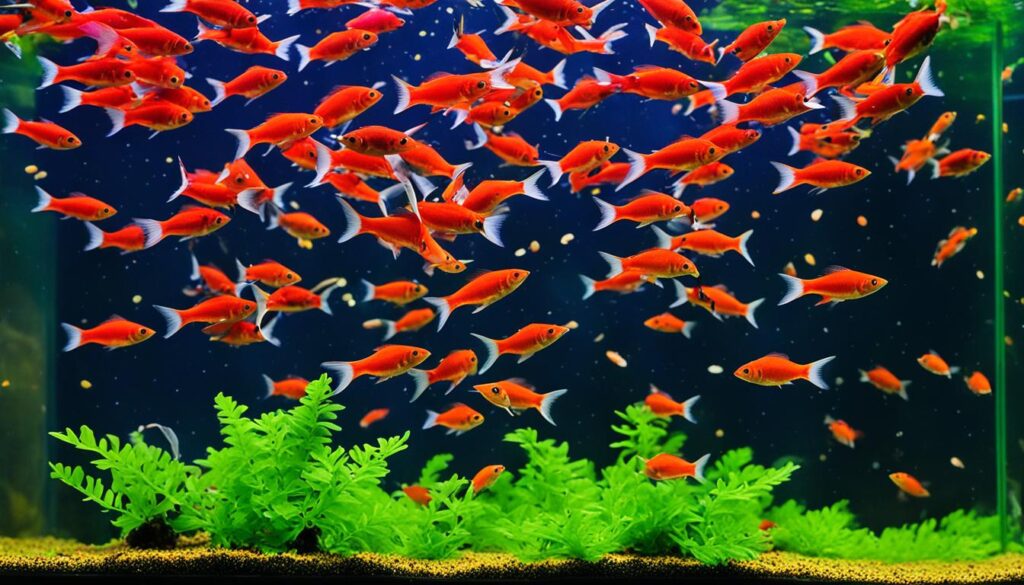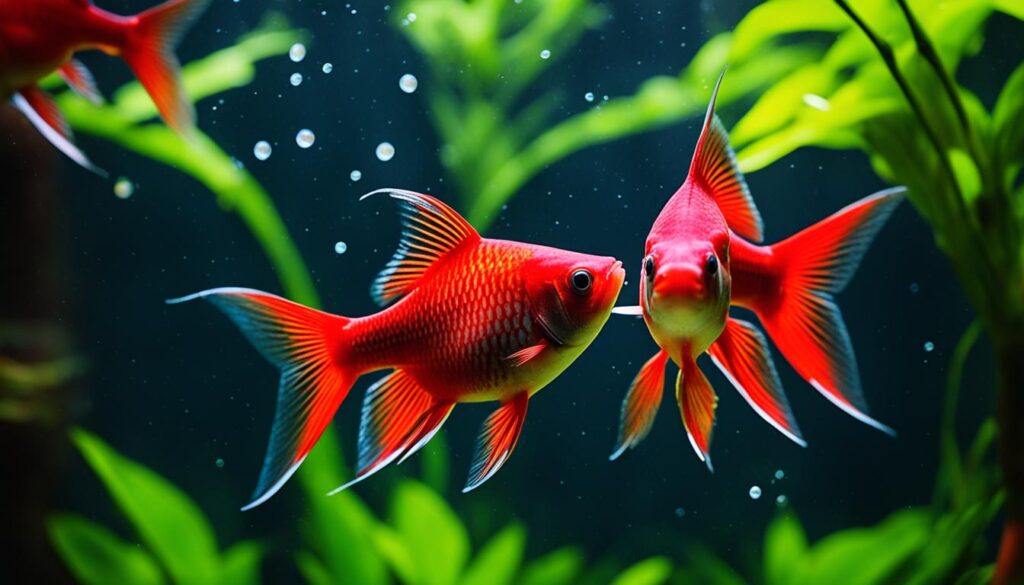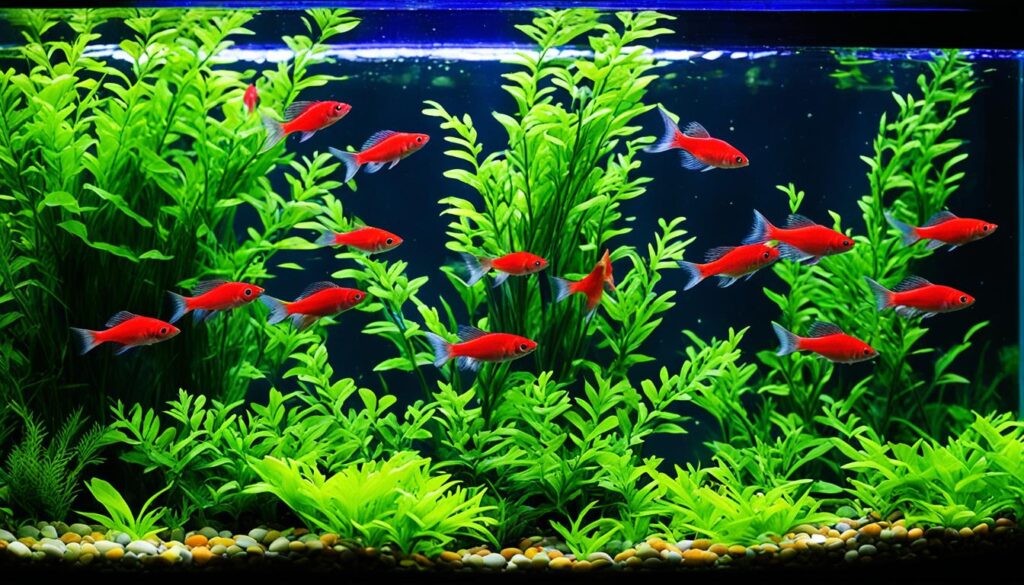Are you looking for a peaceful and vibrant addition to your aquarium? Look no further than the cherry barb! These stunning fish are known for their striking red color and are a great choice for both beginner and experienced fishkeepers. But how can you ensure that your cherry barbs thrive in your aquarium? Let’s dive into our comprehensive care guide and discover the secrets to keeping these beautiful fish happy and healthy.
Key Takeaways
- Cherry barbs are peaceful fish that can thrive in community tanks.
- A well-planted aquarium with hiding spots and natural decor is ideal for cherry barbs.
- Cherry barbs are omnivores and should be fed a varied diet.
- Breeding cherry barbs is relatively easy with the right setup.
- With proper care, cherry barbs can live for 5 to 7 years.
About Cherry Barbs: Appearance and Behavior
Cherry barbs, scientifically known as Puntius titteya, are native to the rainforests of Sri Lanka. The males are bright red, while the females are tannish-red with a black horizontal line running down their sides. These fish have a peaceful temperament and are not aggressive towards other fish. They are active and enjoy swimming in schools. Cherry barbs tend to stay in the middle to bottom levels of the tank and appreciate having plenty of hiding spots.
Cherry barbs are stunningly beautiful fish that add a vibrant pop of color to any aquarium. The males’ bright red coloration is truly eye-catching, and when a school of cherry barbs swims together, it creates a visually stunning spectacle. The females, although not as brightly colored, have their own charm with their tannish-red bodies and distinct black line. Both males and females of cherry barb fish have an elegant and graceful swimming style that adds a sense of tranquility to the aquarium environment.
To ensure the well-being of cherry barbs, it is important to provide them with a suitable habitat in their aquarium. They appreciate having plenty of hiding spots, such as plants, rocks, or caves, where they can retreat and feel secure. The addition of live plants not only enhances the aesthetic appeal of the tank but also provides them with natural hiding places and surfaces to lay their eggs.
Cherry barbs are known for their peaceful temperament and compatibility with other fish species. They rarely show aggression towards their tankmates, making them an excellent choice for community tanks. However, it is essential to pair them with fish of similar temperament and size to avoid any potential conflicts or aggression.
Cherry barbs are active swimmers and enjoy exploring various levels of the tank. They tend to stay in the middle to bottom areas, occasionally venturing to the surface for food. Providing them with an aquarium that offers adequate swimming space and different levels will ensure they have sufficient room to exhibit their natural behavior.
“Cherry barbs are a stunning addition to any aquarium due to their vibrant colors and peaceful behavior. They bring life and energy to the tank, creating a visually appealing and serene atmosphere.”
Cherry Barb Behavior
Understanding cherry barb behavior is crucial for their well-being and optimal care. By observing their behavior, fishkeepers can ensure that their needs are met and detect any signs of stress or illness early on.
Cherry barbs are known to be social fish that thrive in groups. They should not be kept alone but instead should be housed in a school of at least six individuals. Keeping them in larger groups not only promotes their well-being but also encourages their natural schooling behavior, resulting in a truly captivating sight for fish enthusiasts.
These fish are generally peaceful and get along well with other peaceful species. However, caution should be exercised when selecting tank mates, as some fish may exhibit aggressive behavior that could stress or harm the cherry barbs. Similarly, it’s essential to avoid overwhelming them with fast-swimming or large fish that could intimidate or outcompete them for food.
Cherry barbs appreciate having plenty of hiding spots in their aquarium, as they can retreat to these areas when they feel threatened or stressed. Live plants, rocks, and driftwood all provide suitable hiding places and create a more natural and visually appealing environment for the fish.
It is important to note that cherry barbs are not particularly inclined to jump out of the tank like some other fish species. However, ensuring the tank is properly covered is always recommended to prevent any accidental escapes, especially if the aquarium has an open top.
Cherry Barb Breeding Behavior
Breeding cherry barbs can be a rewarding experience for fishkeepers. These fish exhibit interesting breeding behaviors, and successfully breeding them can contribute to the conservation efforts of this beautiful species.
During the breeding process, males may display more vibrant colors and engage in courtship rituals to attract females. This can include flaring their fins, chasing females, and showing off their bright red hues. Females, on the other hand, may become rounder and display a more pronounced black line along their sides.
Cherry barbs are egg layers, and the females will deposit their eggs among plants or on the substrate. To increase breeding success, it is recommended to set up a separate breeding tank with suitable spawning media, such as moss or a DIY spawning mop. The water parameters should be adjusted to mimic their natural habitat, with slightly higher temperatures around 80°F and a slightly acidic to neutral pH level.
Once the female has laid her eggs, the male cherry barb will fertilize them. The eggs will hatch within a few days, and the fry will initially feed on their yolk sac for nourishment. After that, they can be fed with infusoria, live vinegar eels, and powdered fry food until they are large enough to consume live baby brine shrimp.
By understanding cherry barb breeding behaviors and providing the right conditions, fishkeepers can contribute to the ongoing preservation of this remarkable species.
Setting Up the Ideal Aquarium for Cherry Barbs
To create the perfect environment for your cherry barbs, it is essential to replicate their natural habitat found in Sri Lanka. Mimicking their preferred conditions will ensure their health and happiness in your aquarium. Here are some key factors to consider when setting up their ideal tank:
- Aquarium Size: A 10-gallon or larger tank is recommended for a group of six cherry barbs. This provides enough space for them to swim and establish their territories.
- Planted Aquarium: Cherry barbs thrive in a tank with plenty of greenery. The presence of live plants, such as Java fern, Amazon sword, or Anubias, creates a natural and stimulating environment for them. These plants also provide hiding spots and cover for the fish, reducing stress.
- Darker Substrate: Use a darker substrate, such as gravel or sand, to create a contrasting backdrop that highlights the vibrant colors of the barbs. This darker substrate mimics their natural environment and makes them feel more secure.
- Natural Decor: Incorporate natural decor like driftwood, rocks, and caves to provide multiple hiding places and territorial boundaries. This helps replicate their natural habitat and allows the barbs to establish their territories.
- Compatible Tank Mates: Cherry barbs are peaceful and prefer the company of similar-sized and peaceful fish. Compatible tank mates include tetras, danios, cory catfish, and plecos. However, it’s important to introduce fish of similar size and temperament to avoid aggression and ensure a harmonious community.
- Dwarf Shrimp: Cherry barbs can also coexist with certain species of dwarf shrimp, although caution is advised. They may try to go after adult cherry shrimp, so be mindful of their compatibility if you choose to keep them together.
By recreating the ideal habitat for cherry barbs, you can provide them with a comfortable and stimulating environment that promotes their natural behavior and overall well-being. The next section will delve into their feeding and diet requirements, ensuring they receive the optimal nutrition for their vibrant coloration and health.
Feeding and Diet for Cherry Barbs
Cherry barbs are omnivores and have a diverse diet in their natural habitat. Their food sources include small bugs, micro worms, crustaceans, zooplankton, and algae. To ensure their nutritional needs are met in the aquarium, it is important to provide them with a combination of dry, frozen, and live fish foods.
Offering a variety of foods is recommended to ensure cherry barbs receive all the necessary nutrients for their overall health and well-being. Here are some suitable options to include in their diet:
- Nano pellets
- Daphnia
- Spirulina flakes
- Fish foods with naturally red ingredients like krill flakes and baby brine shrimp
These foods will not only provide a balanced diet for cherry barbs but can also help enhance their vibrant coloration, bringing out their signature red hues.

Breeding Cherry Barbs
Cherry barbs are relatively easy to breed. They are egg layers and will lay eggs on plants and substrate. To increase breeding success, it is recommended to set up a separate breeding tank with a bed of moss, catappa leaves, or a DIY spawning mop.
The water temperature should be raised to 80°F and the pH should be mildly acidic to neutral. Once the eggs hatch, the fry will be free-swimming after 1-2 days. They can be fed with infusoria, live vinegar eels, and powdered fry food until they are big enough to eat live baby brine shrimp.

Breeding cherry barbs can be a rewarding experience for fishkeepers. By providing them with the right conditions and proper care, you can enjoy the excitement of watching new life emerge in your aquarium.
Conclusion
Cherry barbs are a beautiful and easy-to-care-for fish species that can thrive in community aquariums. These vibrant fish have a lifespan of 5 to 7 years when provided with the proper care and conditions. Understanding their size and behavior is crucial to creating a suitable environment for them to thrive.
When it comes to size, cherry barbs typically reach a length of 1.5 to 2 inches (3.8 to 5 centimeters) when fully grown. This makes them an ideal choice for smaller aquariums, but they can also be kept in larger tanks as part of a larger community. Providing plenty of swimming space and hiding spots will ensure their comfort and well-being.
To maximize their lifespan and overall health, it is essential to provide cherry barbs with a balanced diet and suitable tank mates. Their omnivorous nature allows for a varied diet consisting of dry, frozen, and live foods. Nano pellets, daphnia, spirulina flakes, and foods with natural red ingredients like krill flakes are great options. As for tank mates, cherry barbs are peaceful and can coexist with other similar-sized and peaceful fish such as tetras, danios, cory catfish, and plecos.
Whether you’re a beginner or an experienced fishkeeper, cherry barbs are a perfect addition to your aquarium. Their vibrant color, peaceful temperament, and easy maintenance make them a popular choice. By providing them with the right environment, diet, and tank mates, you can enjoy the beauty and vitality of cherry barbs for many years to come.

